 Email: support@vespaagogo.com
Email: support@vespaagogo.comFood & Beverages
- Home
- Travel Tips
What is Vietnamese Broken Rice? History & Best Spots in Saigon
2025-11-27
What Is Vietnamese Broken Rice?
At dawn in Saigon, when the city hums awake, the smell of grilling pork cuts through motorbike smoke. Workers grab helmets, students tie their hair, vendors lift metal lids-and beneath the rising steam lies the dish that wakes the city: Cơm Tấm.
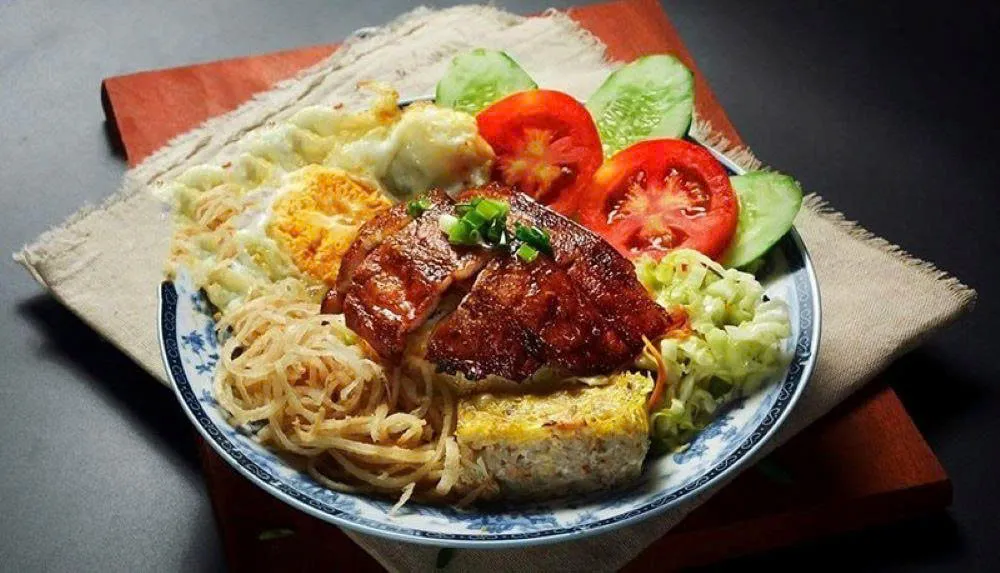
“Broken rice” simply means rice grains fractured during milling. When Vietnam exported long-grain rice during French Indochina, these fragments were unwanted. Yet, Southern farmers saw potential where traders saw defects. Cooked carefully, the grains turned soft, nutty, and fragrant.
Today, this so-called “imperfect” rice defines the national palate. Ask any Saigonese what home tastes like, and the answer comes without hesitation: Cơm Tấm and grilled pork at sunrise.
You can buy broken rice everywhere:
- Markets like Bà Chiểu or Tân Định (sold by weight as gạo tấm).
- Supermarkets (Co.opmart, Lotte Mart, Aeon) or specialty shops.
- Abroad, look for labels such as Vietnamese Broken Rice, Gao Tam, Red Ant, or Three Ladies Brand.
But behind each grain is a history written in smoke, sweat, and resilience.
The Humble Beginning - Farmers and Broken Grains

By the 1930s, the Mekong Delta had become one of the major rice-export regions of French Indochina. Many of the higher-quality long-grain rice were shipped overseas, while locally the cheaper fractured grains (known as ‘broken rice’) were used for domestic consumption. Over time, those humble fragments became the basis for what we now know as Cơm Tấm.
Poor farmers-mostly Khmer and Vietnamese sharecroppers-coudn’t afford the premium rice they grew for others. They collected the broken fragments swept off the floor, washed them again and again, and boiled them with salt, dried fish, or fermented shrimp paste.
Something unexpected happened. The rice, though “damaged,” turned out soft and aromatic, ideal for quick meals during long field days. Thus was born a dish of necessity that would later feed a city’s soul.
Early records from colonial cookbooks even mention “riz brisé à la cochonne grillée” - a French-Vietnamese hybrid meal served by street cooks near Cholon (Chinatown). History doesn’t name them, but those women with charcoal baskets and bamboo poles were the pioneers of Cơm Tấm.
To them, it wasn’t cuisine-it was survival seasoned with pride.
Saigon’s Transformation - From Survival Food to Street Glory
After the wars and economic hardship of the 1950s-1970s, Saigon rebuilt itself street by street. The population exploded; factories and schools needed quick, filling meals. Cơm Tấm became the answer.
Every morning, charcoal smoke rolled down narrow alleys. Vendors hammered small grills from oil drums, fanning flames with woven fans. Pork chops marinated overnight in fish sauce, lemongrass, garlic, and palm sugar sizzled as they hit the grate.
At dawn, the city performed its daily ritual:
- Motorbikes idled in queues beside tiny plastic stools.
- Plates clinked, chopsticks tapped, fish sauce splashed.
- The air smelled of charred meat and mỡ hành (scallion oil).
Each vendor guarded a secret marinade-some added coconut water, others honey or fermented bean curd. Prices were low, but flavors were fierce.
By the 1970s, Cơm Tấm had become Saigon’s breakfast anthem. Even during ration years, people found ways to improvise-using cassava, broken rice, or leftovers-and still called it Cơm Tấm. The dish wasn’t about ingredients; it was about ingenuity.
When you see steam rising from a street grill today, you’re witnessing a century-old performance that never stopped.
The Anatomy of a Perfect Plate
A true Cơm Tấm meal is an orchestra where every instrument matters:
- Cơm Tấm: short, irregular grains steamed until plump yet separate.
- Sườn Nướng: pork chops marinated in fish sauce, sugar, garlic, lemongrass, grilled over charcoal until the fat crisps.
- Bì: shredded pork skin and meat, tossed with roasted rice powder that releases a warm, nutty aroma.
- Chả Trứng: steamed egg-pork loaf with glass noodles-soft, golden, and slightly sweet.
- Mỡ Hành: scallions flash-fried in oil; a bright green gloss over white rice.
- Nước Mắm Pha: a precise alchemy of fish sauce, lime, chili, garlic, and sugar-sweet, salty, spicy, sour in one drizzle.
- Dưa Chua: pickled carrot and daikon for crunch and balance.
Eating it is an act of assembly. Locals mix everything together-no etiquette, just instinct. A spoonful of rice, a bite of pork, a dash of sauce, a sip of iced tea. Each bite re-tunes the palate: smoke meets sweetness, fat meets freshness.
That casual mix is the heart of Southern Vietnamese cooking-flavors layered like daily life: chaotic yet harmonious.
Morning Ritual of Saigon
Cơm Tấm isn’t just a meal; it’s how the city wakes up.
Before 6 AM, office workers in pressed shirts sit beside construction laborers, sharing the same plastic table. Taxi drivers park mid-street for a quick plate; schoolkids clutch styrofoam boxes on their bikes.
The ritual unites everyone. Saigon doesn’t divide by class at breakfast. A plate of broken rice costs little, but it buys equality.
The rhythm is hypnotic: the clang of spoons, the hiss of grills, the vendor’s gentle shout-“Một dĩa sườn trứng bì nha em ơi!” (“One pork-egg-skin combo here!”).
As the sun rises, the city smells of smoke and ambition. That scent is Saigon’s heartbeat.
From Street Smoke to National Pride
By the 1990s, Vietnam opened its doors again. The economy surged, tourism bloomed, and local cuisine began to represent national identity. Street dishes once seen as “poor” became emblems of heritage.
Cơm Tấm was first among equals. It captured the Southern character-open, bold, slightly sweet, endlessly warm.
Upscale restaurants re-imagined it with imported ribs and porcelain plates; home cooks turned it into family Sunday feasts. Even the government recognized its cultural value-Cơm Tấm Saigon was listed among the “Top 100 Vietnamese Culinary Heritage Dishes” by the Vietnam Tourism Association.
Still, the best plates are found not in hotels but on sidewalks where smoke stains the walls and laughter never stops. Because the soul of Cơm Tấm lies not in presentation but in the smell that clings to your clothes and memory.

The Spirit of “Brokenness” - A Cultural Reflection
To most outsiders, “broken” might sound like something flawed or less than whole. But for us Vietnamese, it carries a very different meaning - something that has endured, something seasoned by life.
There isn’t an official proverb about broken rice, yet the feeling it evokes runs deep in our culture. We’ve always believed that even what’s imperfect can still hold beauty and value. Cơm Tấm embodies that idea completely - a dish born from humble scraps, yet loved by millions. Like Vietnam itself, marked by hardship and reborn with pride, it proves that even what is broken can still be fragrant.
When we eat Cơm Tấm, it’s more than a meal; it’s a quiet moment of remembrance. It honors those before us - the mothers who grilled under the rain, the fathers who rose before dawn, the ancestors who turned scarcity into flavor. It’s our way of turning loss into comfort, and memory into warmth,
Com Tam as a Cultural Icon of Saigon
Cơm Tấm has quietly grown from a humble street-dish into a cultural emblem of southern Vietnam. While it may not yet dominate fine-arts exhibitions or viral chart-toppers in a documented way, there are several meaningful markers of its deeper influence.
- The dish is increasingly recognised in food culture: in 2023, it was ranked No.2 among the “Top 100 Most Tasty Rice Dishes in Asia” by TasteAtlas.
- Many food-writing platforms describe Cơm Tấm not only as a meal but as a symbol of Saigon’s working-class identity and culinary resilience.
- Popular travel and food articles (for example from the official tourism site Vietnam National Administration of Tourism) now list Cơm Tấm among the must-try traditional Vietnamese dishes-a cue that its look-and-feel is broadening beyond street-stalls into travel culture.
In short: while it may not yet have a catalogue of songs named for it or museum galleries dedicated solely to it (at least none that are widely documented), Cơm Tấm’s rise from rice-workers’ leftovers to beloved cultural icon is real-and the plate carries meaning far beyond taste. It stands for memory, pride, and the daily life of Saigon.
Broken Rice Where to Buy - 10 Authentic Local Spots in Saigon
1. Cơm Tấm Huyền - Where Saigon’s Morning Starts

A small, unassuming shop tucked into a lively alley, Cơm Tấm Huyền has that old-school charm: the scent of smoke, the clinking of metal trays, the chaos of scooters stopping for breakfast. The grilled pork here is thick and tender, marinated perfectly in fish sauce and sugar, and paired with a rich homemade chili-lime dip.
- Address: 95 Phạm Ngũ Lão Street, District 1, HCMC
- Price range: 50 000 - 70 000 VNĐ
- Opening hours: 6 AM - 10 PM
Signature highlight: Generous portions and perfectly balanced sweetness in the marinade.
Why visit: A hidden favorite among locals who’ve been coming here for years before work or class.
2. Cơm Tấm Minh Long - A Local Gem of District 10
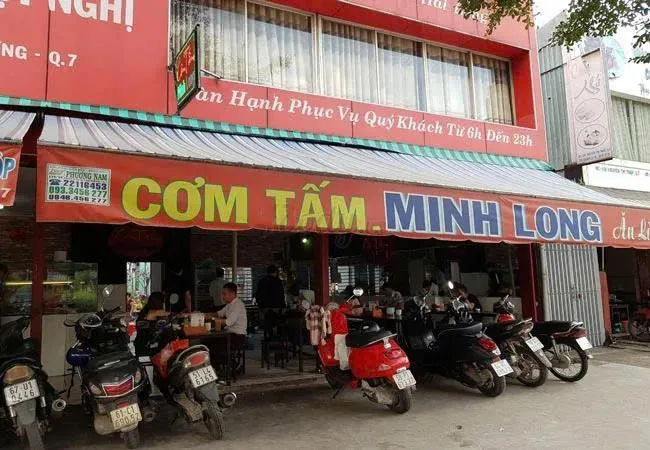
This quiet corner shop delivers pure comfort in every bite. The rice is fluffy, never soggy, and the pork chops are grilled just long enough to get those caramelized edges without burning. You can smell the smoky sweetness from half the block away.
- Address: 236 Nguyễn Tri Phương Street, District 10, HCMC
- Price range: 55 000 - 75 000 VNĐ
- Opening hours: 6 AM - 9 PM
Flavor profile: Soft, well-seasoned meat and light, balanced fish sauce.
Local verdict: Perfect for travelers who want to eat like real Saigonese, without tourist lines.
3. Cơm Tấm Cali - The Reliable Modern Chain
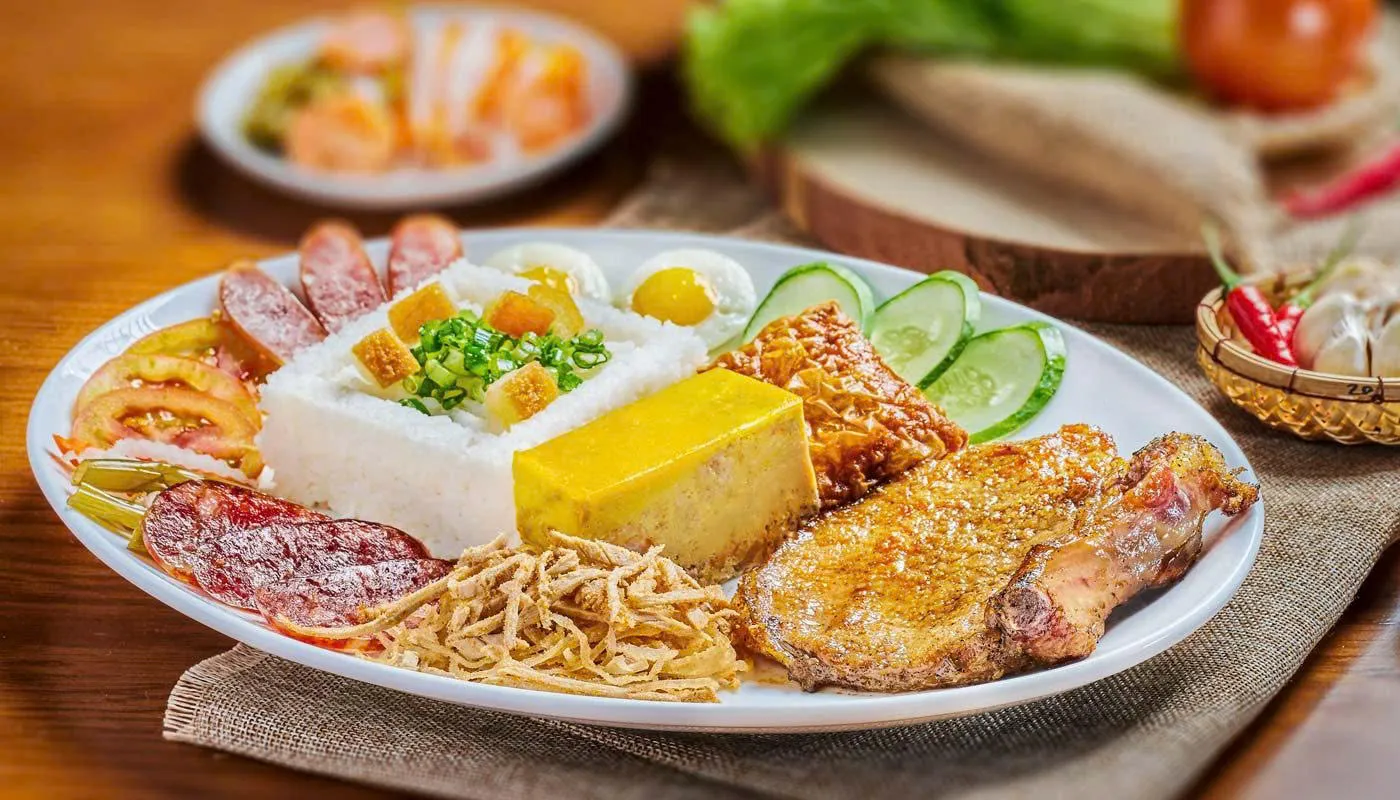
With more than a dozen outlets around the city, Cơm Tấm Cali has become a go-to for both locals and expats. Don’t be fooled by its franchise look-the pork chops are still grilled over open flame, and portions are hearty. The chain’s consistency makes it a safe pick anywhere in Saigon.
- Address: Multiple branches citywide (search “Cơm Tấm Cali near me”)
- Price range: 70 000 - 100 000 VNĐ
- Opening hours: 6 AM - 10 PM
Highlight: Clean, air-conditioned venues yet still authentically Southern in flavor.
Insider pick: Best for those short on time but unwilling to miss a classic Vietnamese meal.
4. Cơm Tấm Phúc Lộc Thọ - Fast, Familiar, Flavorful
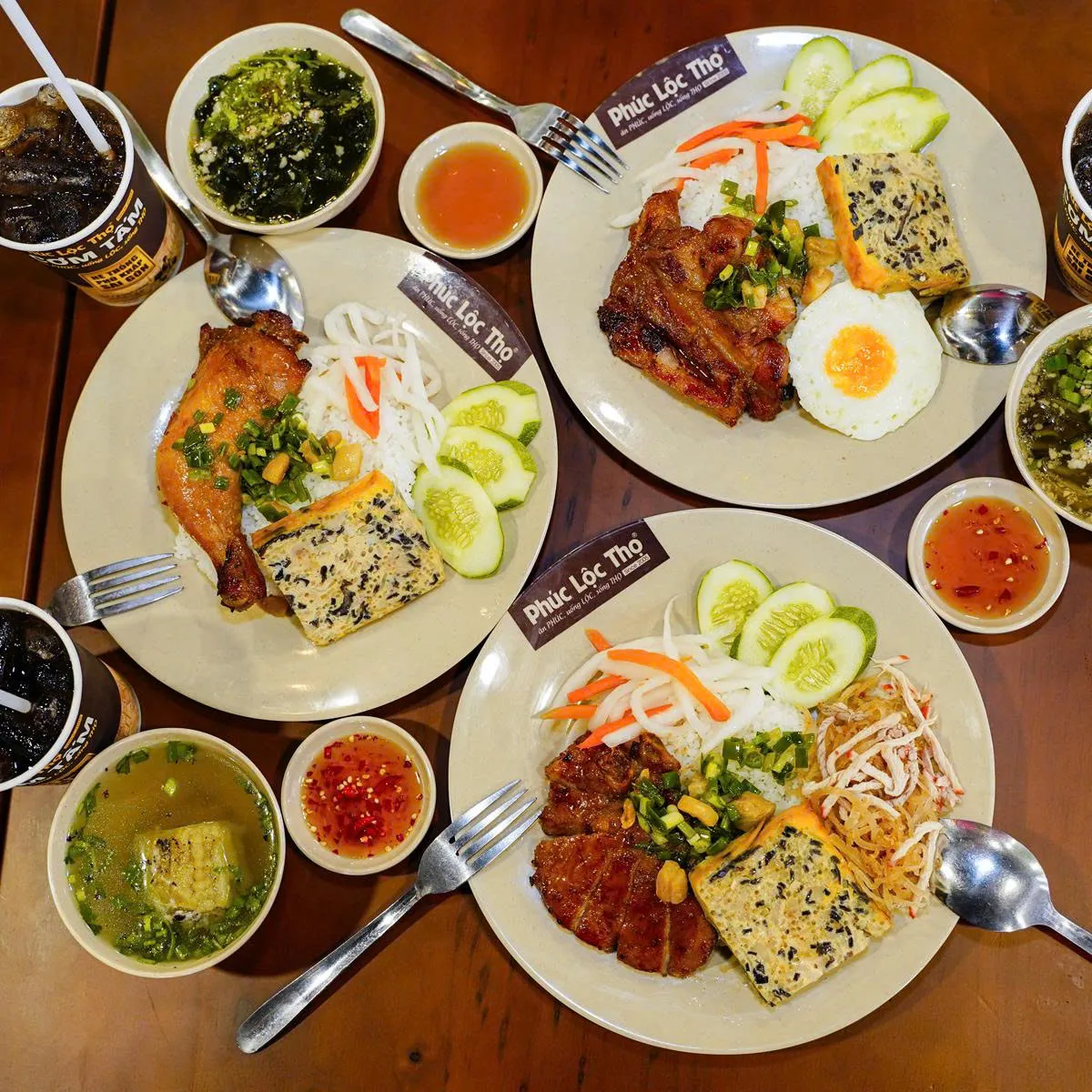
This modern franchise gives the humble broken-rice meal a polished update. The menu stays true to tradition: juicy grilled pork, soft rice, and tangy fish sauce. Everything comes quickly, and the taste is remarkably consistent across all branches.
- Address: 89 Nguyễn Thái Học Street, District 1 (+ branches across HCMC)
- Price range: 60 000 - 90 000 VNĐ
- Opening hours: 6 AM - 10 PM
What makes it stand out: Quick service and a balance between convenience and authenticity.
Why it’s loved: Locals call it their “no-fail” choice when craving Cơm Tấm on a busy day.
5. Cơm Tấm Ba Há - A Heritage Taste That’s Still Affordable
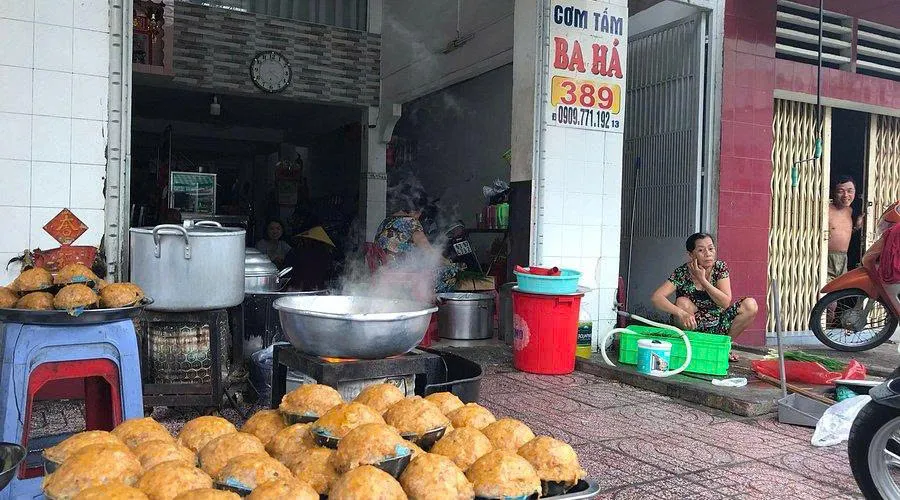
Among Saigon’s older establishments, Cơm Tấm Ba Há holds its ground with smoky pork chops and thick, fragrant rice. The shop has fed generations of workers and students; the décor is basic, but the flavor is unforgettable.
- Address: 389 Hưng Phú Street, District 8, HCMC
- Price range: 55 000 - 80 000 VNĐ
- Opening hours: 6 AM - 9 PM
Key highlight: Decades-old recipe still grilled on traditional charcoal.
Why try it: It’s not touristy-it’s where everyday Saigon eats, plain and proud.
6. Cơm Tấm Sà Bì Chưởng - Pop Culture Meets Tradition
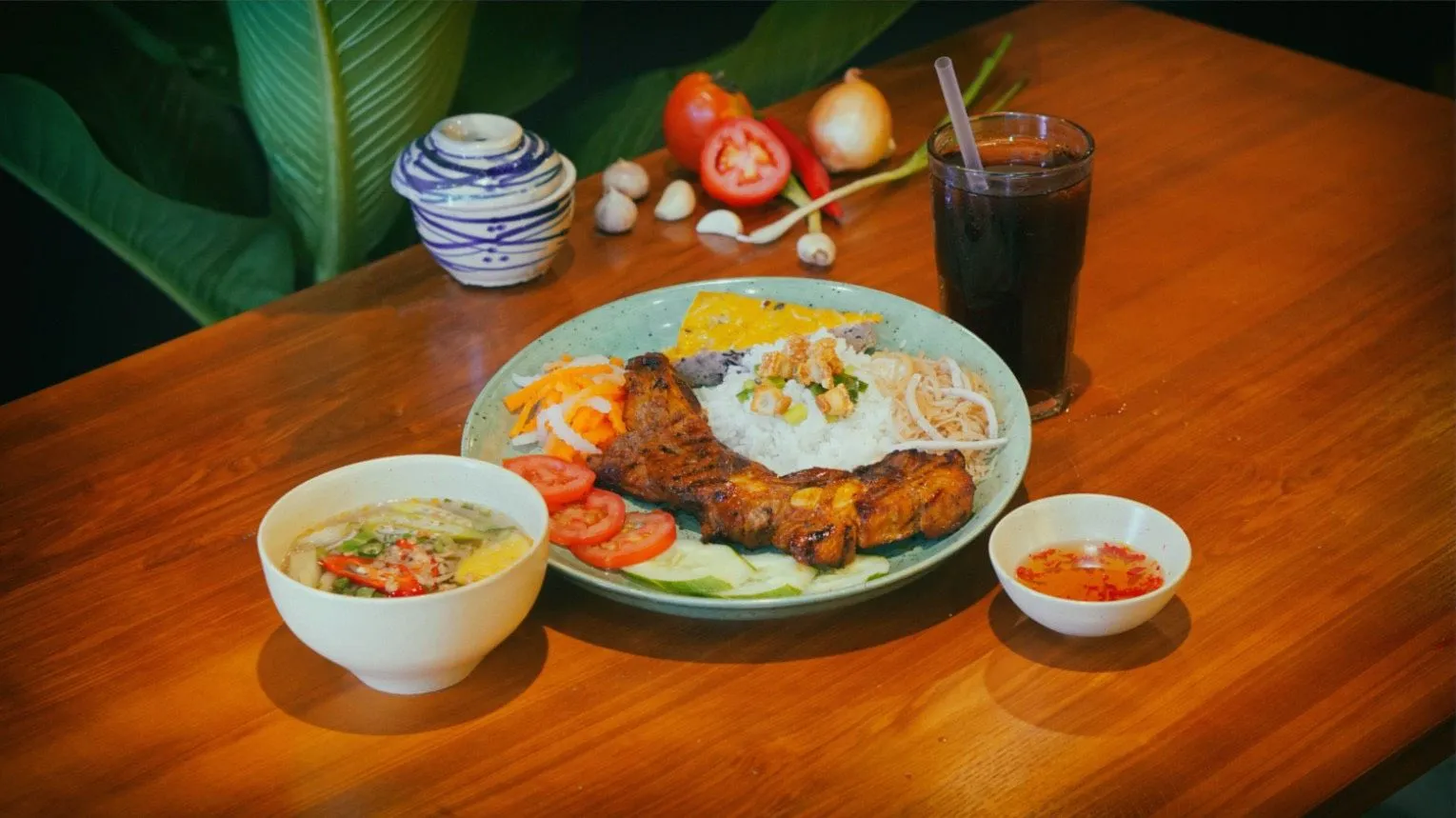
Created by three Vietnamese streamers, this viral restaurant combines humor, modern branding, and authentic flavor. The interior bursts with energy-posters, neon signs, and laughter-but the pork and rice remain textbook Southern.
- Address: 179 Trần Bình Trọng, Ward 3, District 5 | 160 Phan Xích Long, Phú Nhuận, HCMC
- Price range: 80 000 VNĐ (~ $3.2 USD)
- Opening hours: 7 AM - 9 PM
Crowd favorite: Crispy-edged pork, balanced fish sauce, and Instagram-ready plating.
Why it stands out: Proof that even Saigon’s Gen Z still worships the same smoky breakfast their grandparents loved.
7. Cơm Tấm Nguyễn Văn Cừ - Classic Street Corner Charm
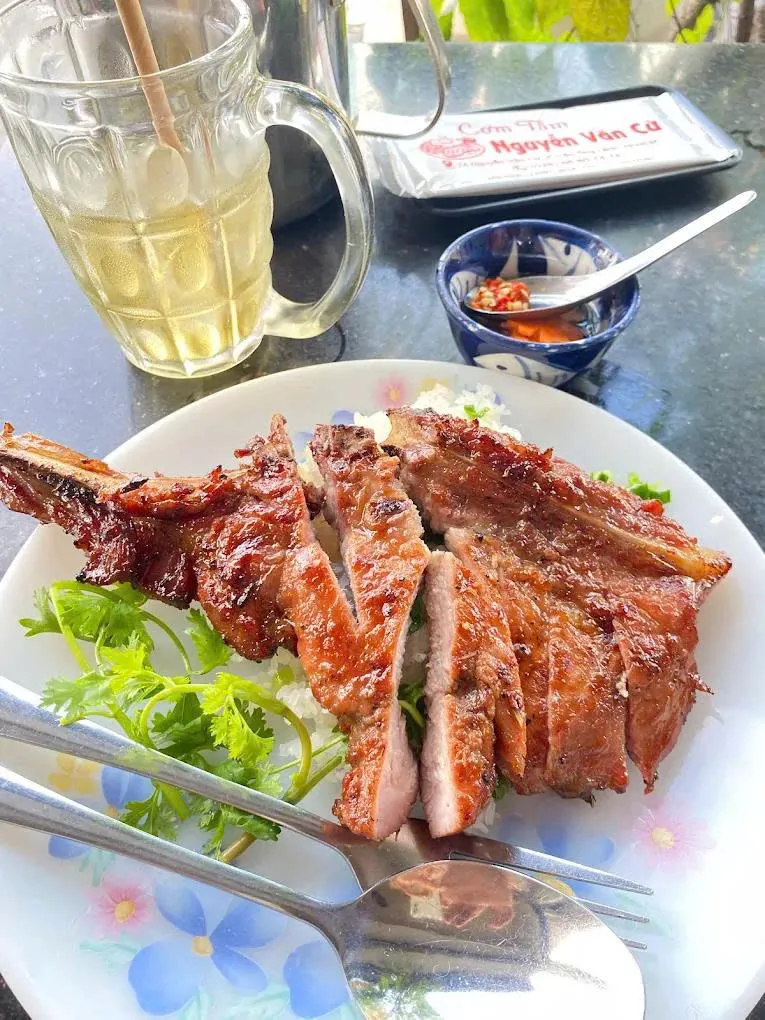
Located on bustling Nguyễn Văn Cừ Street, this famous eatery has transformed Cơm Tấm from everyday street food into a polished dining experience. Expect thick, glossy pork chops grilled over charcoal, rice steamed to perfection, and beautifully plated side dishes. Despite its simple setup, the quality and portion sizes explain why locals call it the “luxury” version of Cơm Tấm.
- Address: 74 Nguyễn Văn Cừ, Phường Nguyễn Cư Trinh, District 1, HCMC
- Price range: 90 000 - 180 000 VND (among the priciest in Saigon)
- Opening hours: 7:00 AM - 3:00 PM (closes after lunch)
Highlight: Extra-large pork chops, rich scallion oil, and consistent charcoal aroma that defines Saigon’s southern sweetness.
Insider note: Come early to avoid the lunchtime crowd - this spot sells out fast, even at its premium price.
Insider pick: Best enjoyed standing with locals while your plate still steams.
8. Cà phê Đỗ Phủ - Cơm Tấm Đại Hàn - When Coffee Meets History
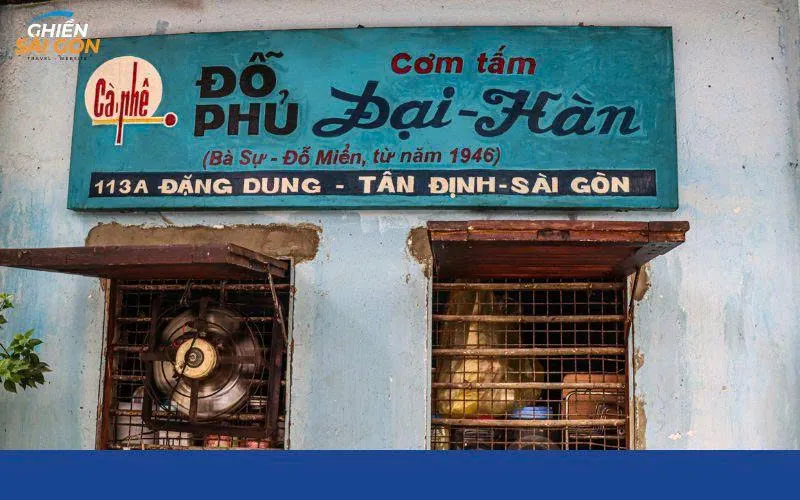
Located inside a French-era villa, Cà phê Đỗ Phủ isn’t just a café-it’s a historical site turned eatery. Besides its famous Vietnamese coffee, the attached Cơm Tấm Đại Hàn section serves tender grilled ribs and homemade kimchi.
- Address: 113 Đặng Dung Street, District 1, HCMC
- Price range: 75 000 - 110 000 VNĐ
- Opening hours: 7 AM - 10 PM
Flavor note: Korean-inspired glaze but still unmistakably Southern in texture.
Why you’ll like it: Combines two Saigon obsessions-coffee and Cơm Tấm-under one nostalgic roof.
9. Quán Cơm Tấm Hòa - Small, Slow, and Soulful
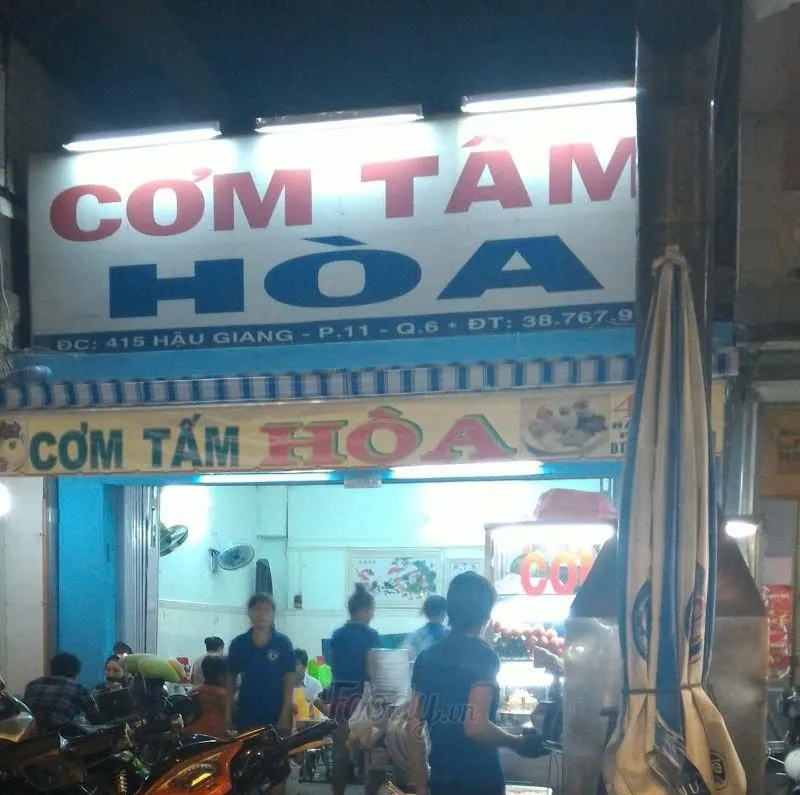
There’s a tenderness to Cơm Tấm Hòa that regulars can’t quite explain. Maybe it’s the slightly thicker rice, maybe it’s the careful seasoning of the grilled pork. Either way, it’s one of those spots you remember long after leaving.
- Address: 42 Lý Thường Kiệt Street, District 10, HCMC
- Price range: 50 000 - 75 000 VNĐ
- Opening hours: 6 AM - 9 PM
Best feature: Balanced flavor and home-style presentation.
Local verdict: Feels like eating in a Saigon auntie’s kitchen-unpretentious and full of warmth.
10. Cơm Tấm Mười - For Those Who Love the Old Ways
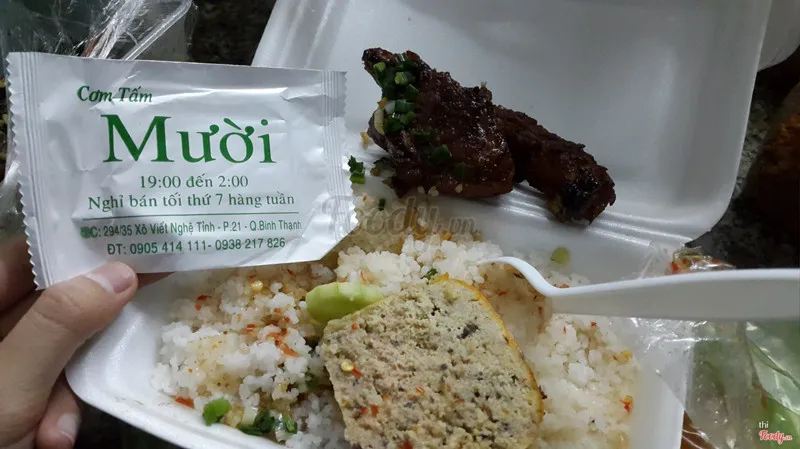
This tiny shop has served the same menu for decades, and locals swear by its smoky pork belly and slightly sweet fish sauce. Don’t expect comfort; expect authenticity.
- Address: 19 Nguyễn Thị Nhỏ Street, District 11, HCMC
- Price range: 45 000 - 65 000 VNĐ
- Opening hours: 6 AM - 9 PM
House specialty: Pork chop grilled over coconut husk charcoal.
Why it’s worth it: One of the few stalls left that still grills meat the traditional way.
11. Cơm Tấm Hùng - The Everyday Hero

Popular with taxi drivers and office workers, Cơm Tấm Hùng serves no-nonsense plates piled high with rice and a mountain of pork. The vibe is noisy and energetic-just how Saigon mornings should be.
- Address: 88 Võ Văn Tần Street, District 3, HCMC
- Price range: 55 000 - 75 000 VNĐ
- Opening hours: 6 AM - 9 PM
Signature taste: Bold fish sauce and extra-crispy fried egg.
Why locals return: Reliable, quick, and always satisfying-pure daily Saigon life.
12. Cơm Tấm Đề Thám - The Backpacker District Classic

Right in the heart of Bùi Viện’s backpacker area, this long-standing eatery keeps things simple but flavorful. It’s one of the few central options that locals also eat at, not just tourists.
- Address: 175 Đề Thám Street, District 1, HCMC
- Price range: 60 000 - 85 000 VNĐ
- Opening hours: 6 AM - 10 PM
Taste note: Slightly stronger garlic flavor and crispy-edged pork.
Insider note: Ideal for travelers staying nearby who want a truly local bite without venturing far.
13. Cơm Tấm Khương - The Quiet Neighborhood Favorite
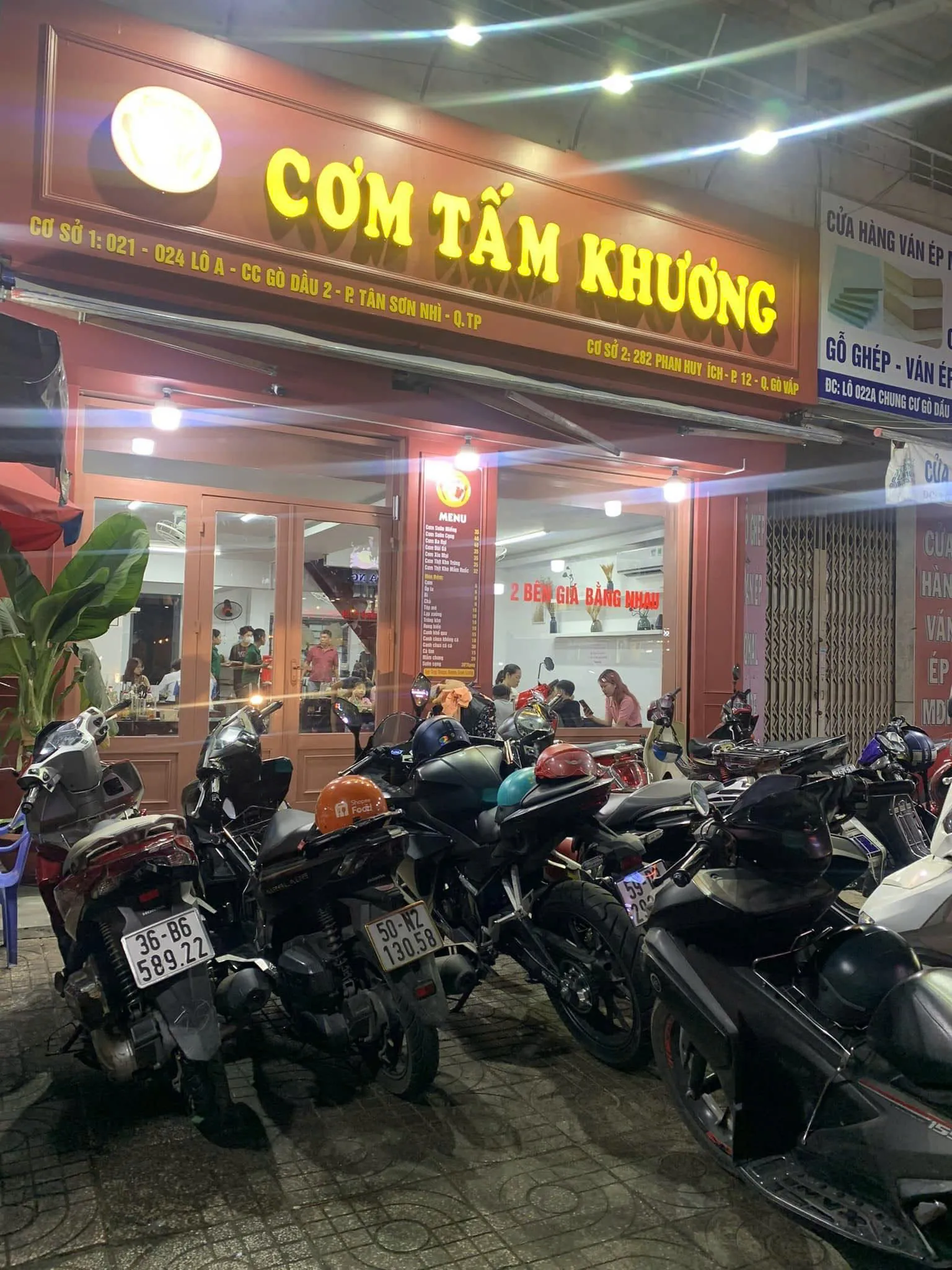
Far from the city center, Cơm Tấm Khương is where Saigon’s suburban families gather. The atmosphere is calm, with soft music and smoke curling from the grill in the back.
- Address: 12 Lê Đức Thọ Street, Gò Vấp District, HCMC
- Price range: 50 000 - 70 000 VNĐ
- Opening hours: 6 AM - 9 PM
Flavor highlight: Marinade heavy on lemongrass and black pepper-simple, aromatic, deeply Southern.
Why it deserves attention: A peaceful local eatery that proves Cơm Tấm isn’t just street food; it’s family food.
14. Cơm Tấm Ba Ghiền - The Benchmark Everyone Mentions
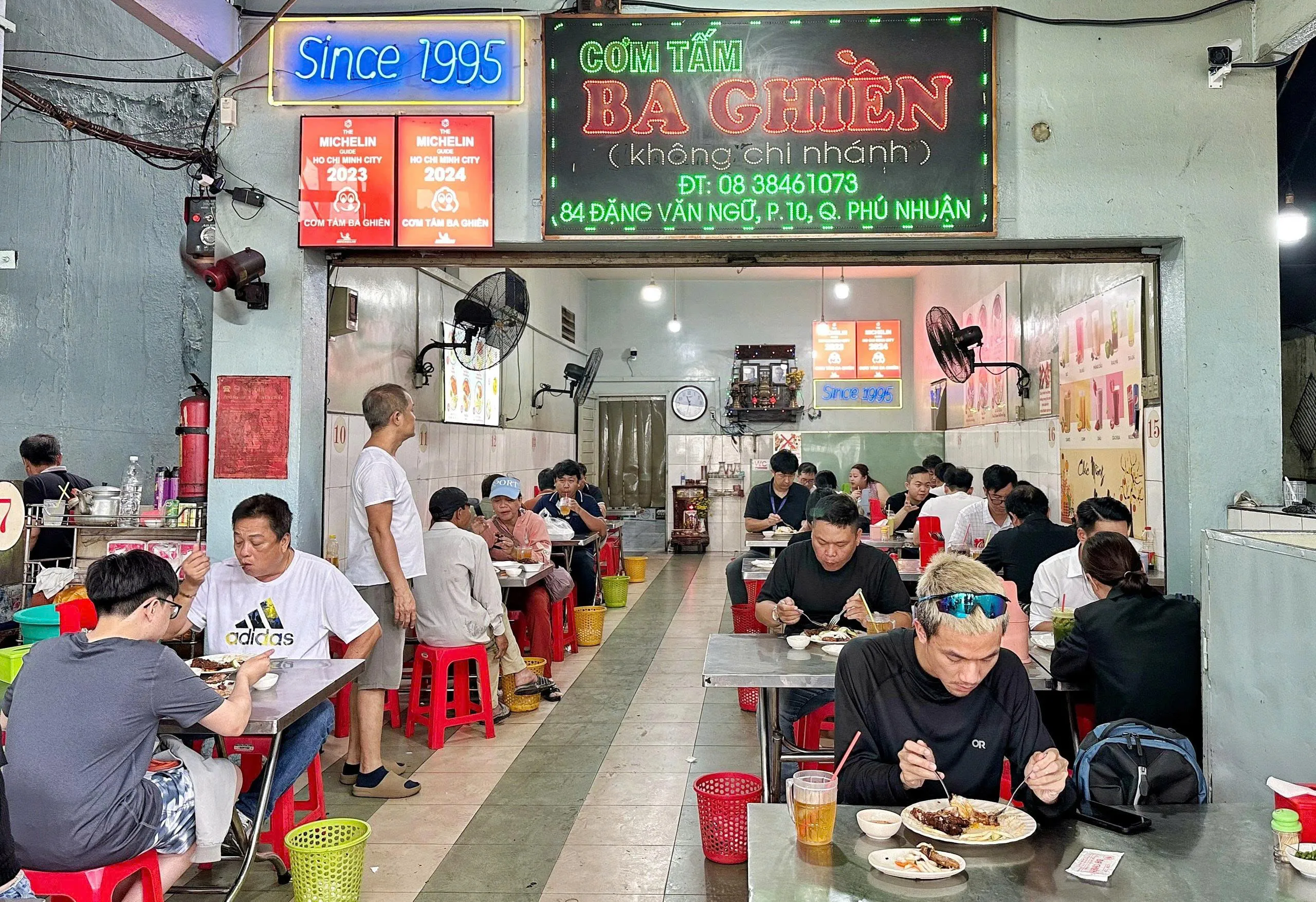
If you ask locals to name a defining Cơm Tấm experience, Ba Ghiền comes up again and again-now a MICHELIN Guide Bib Gourmand pick for quality and value. The signature giant pork chop lands with caramelized edges and deep charcoal perfume; this is the plate many compare others to.
- Address: 84 Đặng Văn Ngữ, Ward 10, Phú Nhuận District, HCMC.
- Price range: typically ~75,000 VND for pork-chop rice; mixed platters up to ~145,000 VND (recent listings).
- Opening hours: commonly listed 6:00/7:00 AM - 10:00 PM (MICHELIN/VN sources list daytime-to-late).
Why it stands out: Three consecutive years named by the MICHELIN Guide (Bib Gourmand)-rare recognition for a humble broken-rice shop.
Local verdict: Big chop, bold marinade, and that unmistakable street-grill smoke-the Saigon yardstick for Cơm Tấm.
The Deeper Meaning of Cơm Tấm
If Phở represents northern elegance and Bánh Mì shows colonial fusion, Cơm Tấm is Saigon’s heartbeat-the comfort that endures through chaos.
Its story mirrors Vietnam’s: colonized, fractured, reborn.
Each plate whispers lessons:
- Perfection is overrated.
- Broken things can feed nations.
- Simplicity is the highest sophistication.
Cơm Tấm teaches gratitude-the kind that starts from scarcity and ends in generosity. That’s why even the wealthiest Saigonese still crave it after a trip abroad: it grounds them, humbles them, heals them.
Final Thoughts
From the Delta’s muddy paddies to neon-lit alleys of modern Saigon, Vietnamese Broken Rice has remained constant-filling bellies, bridging generations, and telling the story of resilience in every grain.
It’s proof that greatness can rise from what was once overlooked.
A plate of Cơm Tấm is history you can taste, heritage you can smell, and belonging you can hold in your hands.
Sang Nguyen - General Manager
I've always been fascinated by the stories behind things. For me, every street corner in Saigon, the historic heart of Ho Chi Minh City, has a tale to tell. For the last 10 years, my passion has been sharing these stories. I want to help you see beyond the surface, to feel the history, and truly connect with the culture that makes this city so special.
Other tips
- The Vietnamese Duck Egg Craze: Why This Delicacy Reigns Supreme in Vietnam
- Popular Vietnamese Snacks: 21 Street Eats You Can't Miss
- What is Vietnamese Broken Rice? History & Best Spots in Saigon
- Vietnamese Bun Rieu: The Ultimate Insider’s Guide to Vietnam’s Famous Crab Noodle Soup
- Hu Tieu Noodles: The Ultimate Guide to Saigon's Secret Soul Food
- 15+ Best Pho in Ho Chi Minh City (2025 Update)
- Common Questions for Vietnamese Food: Safety, Dietary Needs, and Tips for Travelers
- A Saigon Insider's Guide to the 20 Best Coffee Shops You Can't Miss in 2025
- Vietnamese Coffee Culture: From Foreign Plant to National Icon
- Bun Bo Hue: The Spicy Upgrade Your Pho's Been Waiting For
- What to eat in Saigon for travelers and tourists


